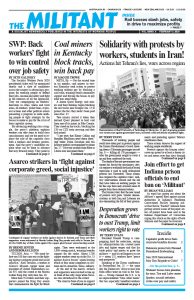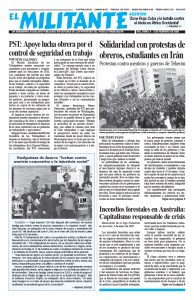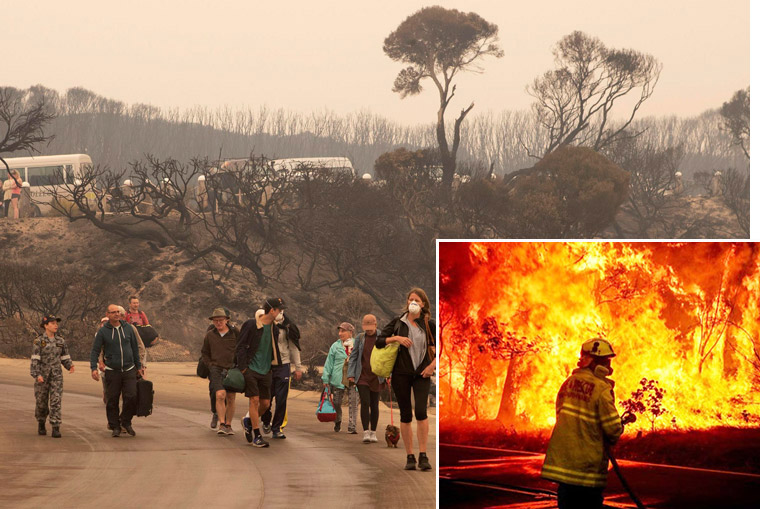BALMORAL VILLAGE, Australia — Supporters of the Militant arrived here, 60 miles southwest of Sydney, to discuss the impact of large-scale fires in December and to offer solidarity.
We found a hub of activity at the local Rural Fire Service station. Voluntary brigades have been central in fighting the massive blazes across eastern and southern Australia for months. Some 72,000 people are organized in more than 2,000 local brigades in New South Wales alone.
The fires have ranged from southeast Queensland down the east coast of New South Wales to Victoria and the island of Tasmania, and from South Australia to Perth in Western Australia.
“We were hit by fire 10 times over three days,” Brendan O’Connor, captain of the Balmoral brigade, told Militant correspondents. Worried that text warnings sent to residents from Sydney Rural Fire Service head office didn’t give enough warning, O’Connor said he “went around and told everyone to get out by tomorrow. If I hadn’t done that there would have been fatalities.”
Volunteers from working people in the district played a key role in both saving lives and people’s homes. O’Connor said the Balmoral brigade has 21 members. Most work outside the district and some travel daily to Sydney. Many had taken weeks off work to fight the fires.
After organizing the evacuation, the brigade fought to save houses, he said, with their station the main refuge as the firestorm surrounded the township. While 21 homes burned down, over 100 were saved. We saw handwritten signs saying, “Thank you RFS” dotting the roadside into the village.
Two volunteer firefighters, Geoffrey Keaton and Andre O’Dwyer from the Horsley Park brigade, in the west of Sydney, were killed fighting the same fire on the road to Buxton, near Balmoral. At least 28 people have died in fires across the country, with more than 2,000 homes destroyed and some 42,000 square miles burned.
For weeks on end, hazardous smoke blanketed Sydney, Melbourne and other cities and towns, as well as rural districts. Farmers have lost an estimated 100,000 sheep and cattle. Hundreds of millions of wild animals have been killed and their habitat destroyed.
Canberra’s obstruction
O’Connor said volunteers had done some hazard reduction burns and helped others with permits to light similar fires on their property. Not enough preventative burns were done in national parks or state forests, which is “most of the land around here,” he said.
He was angry that the Rural Fire Service head office ignored local experience on what was needed to protect people and limit the destructive effect of the fires. The only hazard reduction in a nearby national park was 2½ miles away, he said. With no wildfires or burnoff since 2001, it meant “18 years of fuel” built up. “It was a time bomb waiting to go off,” O’Connor said.
In some districts “some of the country hasn’t been burnt for 60 years, other areas for 25 years, so there is a lot of fuel,” Peter Grieve, a 76-year-old cattle farmer and deputy captain of volunteer firefighters in the Bylong Valley, near the giant Gospers Mountain fire, told the Militant by phone.
He said, “Successive governments [Labor and Liberal] have cut funding over the years” for forestry control and for firefighting resources. The “blocking off of trails” in the forests is a problem, Grieve said. “By the time they got vehicles in there it was too late” to contain what became a monster fire.
A “lot of problems came together,” Grieve said, made worse by an ongoing three-year drought. “You can’t stop the fires, but you can reduce their intensity.”
While we were in Balmoral, a Greek community group from the Earlwood neighborhood in Sydney visited the fire station to show support, bringing meals and children’s Christmas presents for the village. People from nearby brought water and food.
The capitalist rulers’ funding priorities, and their indifference to what working-class and farming communities are experiencing and the social catastrophe they now face, point to the real source of the disaster. There will always be storms, earthquakes and wildfires, but it’s the for-profit dog-eat-dog capitalist system than makes them into a social crisis.
Militant supporters went door-to-door speaking with workers in Tahmoor. “We were told to evacuate,” Janine Hilder, a temp disability care worker, told us. Some stayed to try and save their homes, dousing spot fires from flying embers.
If you don’t have a car to evacuate, or if you’re elderly or disabled, Hilder said, “I don’t know what you’re supposed to do.” Residents were left to fend for themselves. The unplanned evacuation caused a big traffic jam on the road out.
Prime minister heckled
Prime Minister Scott Morrison was heckled by angry residents when he visited Cobargo on the NSW South Coast Jan. 2 for a photo-op soon after the town had been devastated by a fire.
As weeks went by and the social crisis deepened, his government began to scramble to announce new federal measures. Some 3,000 army reservists were belatedly mobilized, and a little financial assistance was announced for the volunteer firefighters. More fire-fighting aircraft were ordered. After thousands of people had been stranded on the beach at Mallacoota by a ring of fires, Morrison finally deployed the navy to evacuate them.
These belated actions just highlighted what hadn’t been done earlier in preparation. The government had known for months that conditions meant fires were likely to be much more intense this summer. Its response, and even the Rural Fire Service state leadership, was “very poor,” Balmoral firefighter O’Connor said. “No one came here for two weeks. These little communities, they don’t care about us.”


